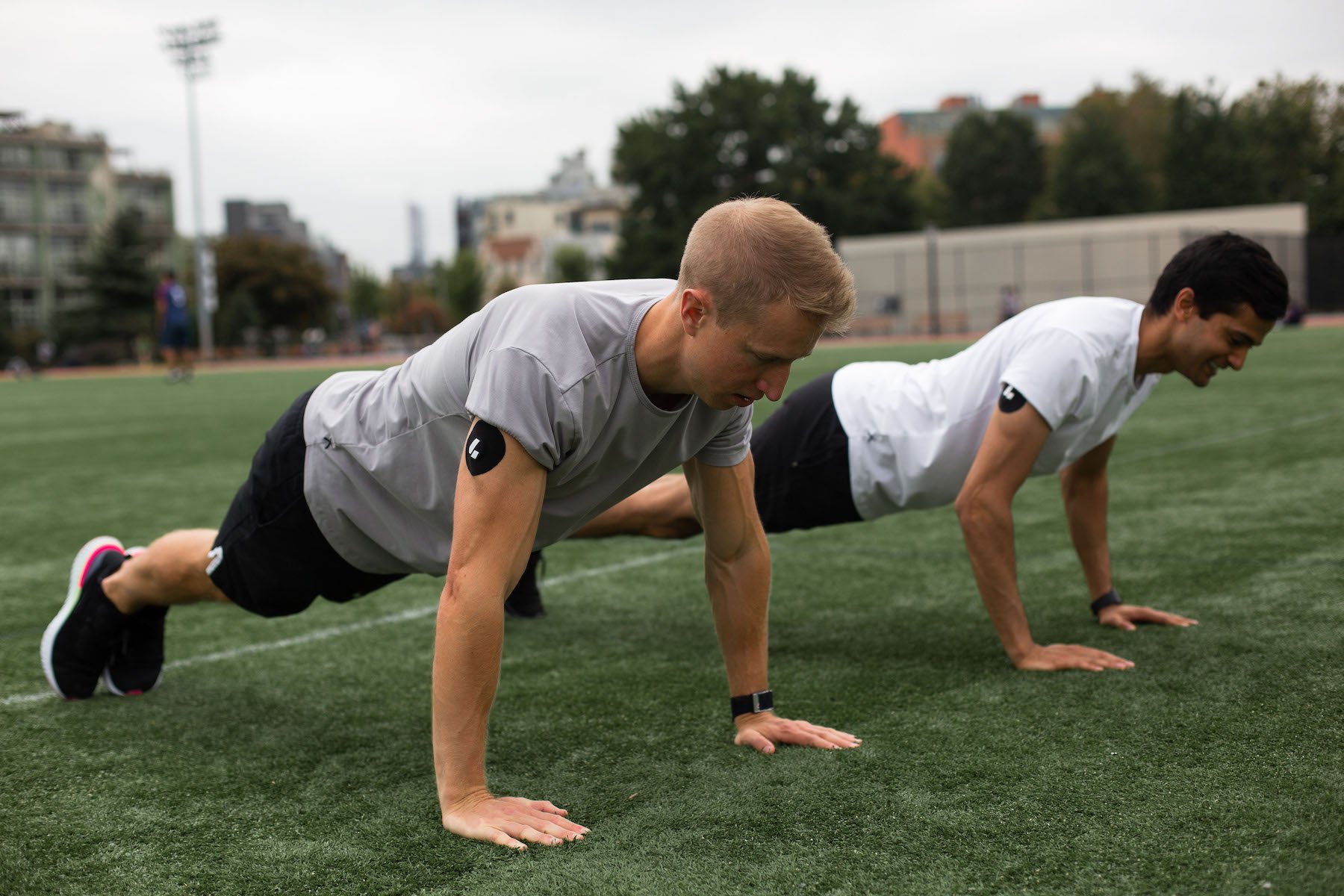Recovery: What Is It?
“Recovery” is a term used in sports to indicate the body’s ability to “bounce back” after exertion, a vital component of exercise training. The recovery process involves resolving exercise-induced skeletal muscle damage, replenishing energy stores, and clearing metabolic waste products generated by the body during exercise. Nutrition is a critical component of any recovery strategy, and tools like continuous glucose monitors (CGM)—which can track how the body processes carbohydrates in real time—can help personalize and optimize an individual athlete’s nutritional strategy.
Who Needs to Think About Optimal Recovery?
Optimizing recovery from exercise is beneficial for elite athletes and weekend warriors alike. Many athletes participate in sports with multiple rounds of events in a single day, like tennis and beach volleyball. For these athletes, short-term recovery and maintenance of energy stores is critical. The gold medals are decided by the last round, match, or heat, so performing your best for the last event is a requirement to win. Some athletes compete in multiple events within a week, such as soccer and football, and these people need to focus on their recovery between days rather than hours.
Recovery from exercise is also essential for recreational athletes who want to optimize their body’s adaptations (i.e., getting bigger, faster, stronger, etc.) to look and feel their best and perhaps not feel so sore the morning after a round of pick-up basketball.
Why Do We Care?
Effective recovery is vital for two main reasons:
- Restoration of performance
- Injury prevention
A study on English Premier League soccer players found that it can take up to 120 hours to restore the disturbances in metabolic and physical performance induced by a single soccer match. Athletes rarely have 120 hours to fully recover without any competitions or training. Anything we can do to speed up this process is valuable.
When athletes become fatigued, they are more prone to injury. Soccer players in the English Premier League who play two matches per week have a 6.2-fold higher injury rate than players competing in just one match per week. Also, injury risk increases when less than 96 hours separate soccer games. If we improve the speed and efficacy of our recovery tactics, we can minimize fatigue in back-to-back competitions and reduce injury risk.
For the recreational athletes among us, recovering properly can also benefit our overall health. We can improve overall health by being smart about how we treat our bodies and fuel after exertion. On the flip side, mismanaging post-workout recovery can set us back in terms of health. For instance, while we might think that our post-workout protein recovery shake is doing us good in helping us build muscle, its added sugar may be sending our glucose levels through the roof and causing unnecessary inflammation and damaging oxidative stress.
New tools like continuous glucose monitoring can help us dial in our personalized recovery plans, particularly regarding nutrition. As we try to strike a balance between replenishing our energy stores, minimizing damage to our tissue, and determining the optimal amount of hydration, CGM can give insight into whether we are hitting the “sweet spot.”
Why Focus on Nutrition?
Athletes use numerous strategies to enhance recovery. Some popular options include massage, cold water immersion, stretching, compression garments, cardiac biofeedback through wearables like Whoop, and nutritional support.
Nutrition is crucial because it is well-studied in the scientific literature, easily accessible, and cost-effective.
This article will focus on four areas of nutrition that you can target to optimize recovery and perform your best over and over (and over!) again. Recovery nutrition is involved in the following:
1. Replenishing glycogen stores. Glycogen is the body’s quick fuel for high-intensity or power athletic events and must be replenished between back-to-back athletic events to ensure optimal performance.
2. Optimizing anabolic adaptations: rebuild and repair. Anabolic processes in the body are those that build tissue. If we break down muscle during an athletic event, we must initiate anabolic processes that can rebuild this tissue. Proper nutrition can support this by providing the building blocks for protein synthesis.
3. Replenishing lost sweat: hydration. Fluid and electrolyte loss during exercise is inevitable and, if not addressed, can severely hinder performance and metabolic health.
4. Reducing inflammation and oxidative stress. During recovery, athletes must be mindful of excessive oxidative stress to prevent as much cellular damage as possible. Reducing oxidative stress also improves metabolic health for the general population.
1. Replenishing Glycogen Stores
Glycogen is a quick fuel source stored in your muscles and liver made from chains of glucose. It is the primary energy source for high-intensity exercise (greater than 80% VO2 max) and maximal muscle contractions. For athletes performing sprints, explosive efforts, or anaerobic activities, glycogen replenishment is important for repeated efforts of maximal performance.
Restoring glycogen levels is particularly important for athletes who have back-to-back workouts within 24 hours of each other and perform high-intensity or power sports. These athletes may deplete their glycogen stores significantly during an event and are at risk for worsened performance if they don’t replenish.
Elite athletes striving for glycogen replenishment should consume carbohydrates immediately after exercise to take advantage of the increased blood flow and insulin sensitivity available for a limited time just after a workout. The benefits of eating carbohydrates immediately compared to waiting two hours after exercise were shown in a study that found delayed feeding lowered muscle glycogen concentrations by 45%.
If we choose to refuel immediately after exercise, how much and what types of carbohydrates should we eat? Research studies found the highest rate of glycogen synthesis in people consuming 1-1.2 grams carbohydrates/kg body weight per hour after exercise. For a 170-pound (77 kg) person, this equates to 77-92.4 g of carbohydrates per hour (e.g., two medium baked sweet potatoes and one cup of long-grain brown rice, 90.8 g carbohydrates). If you think this is a large volume of carbohydrates, it is! This amount of carbohydrate consumption is an essential strategy for athletes involved in a competition requiring many events in a single day. It’s important to remember that this large intake of carbohydrates is unique to elite athletes and far too much for the average person who is unlikely to be depleting their glycogen stores and, therefore, doesn’t need to replenish them as rapidly.
When seeking to restore glycogen as quickly as possible for a back-to-back athletic event, high glycemic index (GI) foods (such as oatmeal, white rice, baked potatoes, and liquid carbohydrates like sports drinks) are preferred for the first six hours after exercise, compared to slower-digesting, low GI foods (such as beans, lentils, or leafy greens). If your next workout isn’t for another 24 hours, however, there is no difference between high or low-GI foods, and you can recover appropriately by consuming low-glycemic meals, as there is plenty of time to “fill the tank” of glycogen.
If you’re an athlete starting on a low carbohydrate diet, practicing carbohydrate cycling, or following a ketogenic diet, some options don’t require you to eat as many carbohydrates but still provide adequate recovery and glycogen replacement. If your carbohydrate intake is low for the day (less than 1.2 g/kg/day), then consuming 0.4 grams/kg/hour of protein with 0.8 grams/kg/hour of carbohydrate can achieve a glycogen resynthesis rate similar to 1.2 grams/kg/hour of carbohydrates without protein. It is unclear why this is the case, but it may be because the combination of glucose and protein generates a higher level of insulin release than glucose or protein alone, which may allow glucose to be taken up more efficiently.
For the average recreational athlete, rapid glycogen replenishment is much less critical to think about. Typical glycogen stores will be enough to fuel a short, intense workout, and lower-intensity workouts will be supplied primarily by body fat. In fact, excessive carbohydrate consumption could actually be damaging by loading the body with glucose it doesn’t need. See our blog post “Using Continuous Glucose Monitoring to Guide Fueling for Peak Athletic Performance” for more information.
How can I use my CGM as a guide?
When ingesting carbohydrates for glycogen resynthesis, you will likely see a corresponding rise in glucose levels on CGM, which should return to pre-eating levels within two hours. It’s essential to remember that repeated high blood glucose spikes from carbohydrate ingestion are unhealthy. You can imagine it would be easy to overshoot when attempting to quickly replenish carbohydrates and generate massive glucose elevation. Refueling options that don’t create excessive glucose spikes is likely an excellent strategy to avoid this. While there is no well-defined threshold, aiming to stay below 140 mg/dL blood glucose and ensuring glucose returns to baseline within two hours is likely optimal for the athlete’s body.
2. Optimizing Anabolic Adaptations: Rebuild And Repair
Just as carbohydrates are your nutritional tool for glycogen resynthesis, protein is your nutritional weapon of choice to master muscular recovery. Protein stimulates muscular adaptation, repairs damaged muscle fibers and enhances anabolic adaptations. “The golden hour” is a phrase used in athletics to refer to the optimal one-hour window after exercise when it is believed that ingesting dietary protein will elicit the most significant increase in muscle protein synthesis.
How much protein should we eat? Formerly, it was accepted that consuming 20-25 g of protein post-exercise was optimal for muscle protein synthesis. However, a recent study showed that 40 g of protein after exercise elicits greater myofibrillar protein synthesis, irrespective of lean body mass.
How can I use my CGM as a guide?
Dietary protein has minimal effects on blood glucose levels when eaten alone. When protein is consumed with carbohydrates, however, it can reduce the magnitude of the blood glucose response to the carbohydrates, leading to a lower post-meal spike. As such, when eating carbohydrates as part of a refueling strategy, pairing them together with protein can lessen glucose fluctuations and minimize the amount of carbohydrates needed to replenish glycogen.
3. Reducing Lost Sweat: Hydration
Exercise increases metabolic heat production, raises body temperature, and we sweat to cool down. Everyone’s thermoregulating properties are unique, so some people sweat significantly more than others. Rehydrating immediately post-exercise aims to replace the volume and structure of fluids lost through sweat. Generally, you want to consume 150% of the fluid lost during exercise (the extra 50% comes from urine fluid losses) post-exercise.
Most people can monitor whether or not they are well hydrated by the color of their urine. Clear urine indicates you are adequately hydrated, while yellow pee indicates dehydration. To be more quantitative about your hydration, weigh yourself before and after exercise and replenish accordingly. If you lost 1 kg during training, you need to drink 1.5 kg of fluid (equivalent to about 1.5 L). Complete rehydration can be achieved in about six hours, which can be minimized by drinking during breaks in competition. Be mindful that temperature and humidity can accelerate the sweat rate, so act accordingly.
How can I use my CGM as a guide?
Dehydration causes the release of a hormone called vasopressin. Vasopressin helps regulate the body’s water retention, signals the kidneys to store water, and allows the liver to break down glycogen and release glucose. If you see a rise in your blood glucose levels on your CGM, it could indicate that you are dehydrated. Monitoring and cross-referencing your blood glucose readings with easy-to-measure indicators (like urine color) can help provide insight into how much your blood glucose changes with your hydration status.
4. Reducing Inflammation And Oxidative Stress
Exercising at a high intensity produces free radicals: metabolic byproducts that are reactive in the body and can damage surrounding structures and cause subsequent inflammation. Antioxidants can neutralize these reactive molecules, but when there is an imbalance and excessive levels of free radicals, this state is called “oxidative stress.”
The harder the workout, the more free radicals you produce, and the greater the potential for oxidative stress. This can be beneficial to a certain extent. The inflammation and free radicals produced by exercise signal to your body that the exercise is challenging, and in response, your body takes action to adapt. Specific types of free radicals appear to be generated in a controlled manner by skeletal muscle fibers in response to exercise and serve to optimize the contractile performance of muscles and initiate adaptive changes in gene expression.
This sounds great, right? You may be thinking, “Bring on the free radicals!” Not so fast. Free radicals are generated from intense exercise but can also be produced by biological stressors like poor diet, elevated post-meal glucose levels, chronic stress, sleep deprivation, cigarette smoke, alcohol, smoked foods, processed vegetable oils, and exposure to pollutants. High levels of free radicals are associated with multiple diseases, including cancer, inflammatory joint disease, fibromyalgia, migraines, asthma, and diabetes. Repeatedly increasing free radical production beyond what your body can manage can lead to unhealthy outcomes.
A person eating a typical American diet, stressed out by work, staying up late to work through their to-do list, and having a few drinks each night will likely generate significant amounts of free radicals. For this type of person, exercise can be a great lifestyle addition, but high-intensity exercise could add fuel to the fire of pre-existing excessive oxidative stress. By reducing oxidative stress triggers in our daily lives, we can benefit from exercise while also warding off increases in free radicals.
As previously mentioned, for athletes, controlled free radical generation by muscles can drive adaptations. Similarly, a small amount of free radicals is required by cellular machinery for optimal force production in skeletal muscle, but high levels of free radicals promote contractile dysfunction, resulting in muscle weakness and fatigue.
Antioxidants and polyphenols (antioxidant chemicals that naturally occur in plants) are molecules that counteract free radicals by binding to them and neutralizing them. Some foods high in antioxidants or polyphenols are dark chocolate, green tea, coffee, berries, vegetables, nuts, and spices. There are multiple recovery protocols utilizing antioxidants in the research literature that are effective at reducing oxidative stress and muscle damage. In one study, drinking 0.682 L tart cherry juice before and after exercise significantly reduced symptoms of muscle damage. In another, theaflavin-enriched black tea extract reduced oxidative stress and muscle soreness after aerobic intervals.
How can I use my CGM as a guide?
It’s well-established that high blood glucose can lead to oxidative stress, so keeping glucose levels as stable and healthy as possible may be beneficial for athletes trying to reduce fatigue that results from excessive oxidative stress. Avoiding excessive spikes is a good indication that you are not generating undue oxidative stress from the source. Maintaining a low and stable glucose line on rest days may help the body minimize glucose-associated oxidative stress.
Antioxidant intake as part of a recovery strategy may also feed back into helping improve glycemic control. One study on diabetic mice found that a treatment of 10-16 weeks of an antioxidant cocktail (N-acetyl-L-cysteine, vitamin C, and vitamin E) reduced blood glucose levels (measured by a glucose tolerance test). The study also found significantly larger beta cell mass in the pancreas after antioxidant supplementation, indicating an increased capacity to secrete insulin. In humans, a study looking at antioxidant supplementation for eight weeks showed an improvement in insulin resistance by 15%.
Taken together, these studies indicate that diets high in antioxidants may be protective against fatigue-generating excessive oxidative stress and that diets that maintain stable and healthy blood glucose levels may reduce the generation of oxidative stress.
Supplements, Recovery, and Glucose
There are countless supplements on the market, and knowing which will aid in recovery can be challenging. Creatine and caffeine are two that have been shown to have notable benefits on athletic performance and also impact glucose regulation:
Creatine
Creatine is a substance found naturally in muscle cells. Supplementing your natural stores of creatine with a micronized form is traditionally utilized for gains in strength, power, and explosiveness. This supplement has been extensively researched with regard to athletic performance, and a few studies are emerging that point toward its efficacy for reducing mental fatigue caused by mental activity, sleep deprivation, or traumatic brain injury.
In addition to all the benefits mentioned above, muscle glycogen resynthesis is improved following creatine supplementation. Creatine may also decrease blood sugar by increasing the function of glucose transporter type 4 (GLUT-4). For this reason, it is possible to see a dip in blood glucose levels if you supplement with creatine.
Caffeine
Caffeine may improve recovery via enhanced glycogen resynthesis. Research has shown that ingesting 8 mg/kg of caffeine with 4 grams/kg carbohydrates results in 66% greater glycogen accumulation after four hours of recovery, as opposed to 4 grams/kg carbohydrates without caffeine.
In addition to improving glycogen resynthesis, caffeine can also benefit metabolic health. A cross-sectional study showed that caffeine is associated with lower fasting blood sugar and HbA1c values and higher levels of the hormone adiponectin. Adiponectin is an anti-diabetic hormone that modulates metabolic processes, including glucose regulation, the body’s response to insulin, and fatty acid oxidation.
Conclusion
Effective recovery is critical for athletes facing back-to-back events, as well as recreational athletes trying to bounce back from a challenging workout and minimize soreness and fatigue. Nutrition is a lynchpin of an effective recovery strategy. It can offer building blocks for tissue repair, replenish energy and fluid losses, and serve as signaling molecules for genetic pathways associated with recovery. Carbohydrate-rich recovery nutrition may impact blood glucose levels to replenish glycogen stores, but it is important not to overshoot and generate excessive glucose spikes, as high glucose levels can cause excess oxidative stress, which can promote fatigue.
Continuous glucose monitoring can offer an objective peek into how recovery strategies are affecting the body in many ways:
- In the case of refueling energy stores via carbohydrates, CGM can let us know whether we are overshooting our carbohydrate needs and generating an excessive spike that could be detrimental to our recovery goals. The elite athlete who needs to get carbs in quickly before their next event may see a higher-than-normal glucose elevation but not want to see it skyrocket. For recreational athletes at less risk for depleting glycogen and for whom it is less necessary to replenish rapidly, CGM can help these people stay on track to keep their glucose line stable and healthy before and after workouts.
- CGM can tell us how protein intake alone, versus protein intake with carbohydrates, differentially affects our glucose levels. We need protein to build and repair muscle tissue and simultaneously use protein to buffer excessive glucose spikes from carbohydrate intake via the impact of protein on insulin secretion.
- Given the relationship between dehydration and elevated blood glucose, CGM can offer a window into hydration status and the need for more fluids.
- CGM can give us a long-term picture of our free radical and antioxidant balance. We know that high blood sugar spikes generate oxidative stress that can be counterproductive to recovery (and we want to avoid these). We also know that our body’s antioxidant capacity is associated with better metabolic health. With this, we can use our CGM data to reinforce the long-term need to consume many antioxidant-rich foods, reduce oxidative stress via antioxidants, and enhance glycogen resynthesis via supplements.
In this way, you can use your CGM to your advantage and make the recovery process as healthy, least damaging, and productive as possible.








